Just before noon on Thursday the Gay Head Light departed the spot where it has stood for 159 years. The Island’s oldest lighthouse is now headed for its new home about 175 feet from the eroding clay cliffs.
The brick-and-mortar lighthouse stands within an enormous excavation, balanced on a 100-ton steel frame rolling slowly along two massive steel beams, toward a large concrete pad 129 feet to the east.
In a sudden change of plans this week, the Gay Head lighthouse committee announced that the move would begin 14 days ahead of schedule. Project managers now expect the lighthouse to reach its destination this weekend. By late afternoon Thursday the lighthouse had covered 52 feet without incident.
Only five workers were on site Thursday, and that is likely all it will take to complete the move, said Jerry Matyiko, president of Expert House Movers. On Thursday morning Mr. Matyiko sat in an orange Kubota, cigar clenched in his teeth, lifting the 50-foot travel beams into place, a surprisingly fast process.
About 30 people, including filmmakers and members of the press, gathered atop the concrete pad Thursday morning under a cloudy sky to witness the start of the move. The movement itself is nearly imperceptible, indicated mostly by the mechanical whirring of a generator and the hiss of pneumatic pumps.
The project will continue long past the move, with foundation work, landscaping and renovations still to come, but the 129-foot journey has attracted wide attention. Time-lapse cameras and webcams were positioned on tripods around the site, with a drone and two helicopters circling overhead in the afternoon.
Early in the day, a small group of second and third graders from the Chilmark School visited the site as a steady drizzle fell. Len Butler, chairman of the lighthouse relocation committee, along with lightkeeper Richard Skidmore, answered questions, emphasizing the history of the lighthouse and its connections to Island culture. “We’re going to fix it up so it looks like the day it was built,” Mr. Butler said. More students will visit on Friday and public viewings are scheduled for Saturday from 10 a.m. to 4 p.m.
Preparations have been under way for several weeks, with as many as 15 workers on site at once, in addition to engineers, archaeologists, filmmakers and others involved in the project.
Richard Pomroy, owner of Pomroy Associates, who is the general manager for the project, said the teamwork among the various contractors and consultants has been exceptional. “We’ve been really running a tight ship,” he said.
“Everybody has worked together almost seamlessly,” agreed Mr. Butler. “We actually shaved several weeks off our schedule just because everything worked like clockwork here.”
Island excavator John Keene removed thousands of tons of material from the site this spring.
Mountains of soil and clay are being stored in the town parking lot at the bottom of Aquinnah Circle. During periods of heavy traffic the town will open part of the field within the Circle to parking. Residential parking spots near the rest rooms at the bottom of the hill will also be open.
At a press conference Thursday at the project site, Mr. Pomroy said backfilling may begin as early as Wednesday. Mr. Butler said the goal was to reactivate the light sometime in July, noting that the lighthouse is more than just a beautiful structure.
“It has a very important mission,” he said. “This beacon will continue to be an active aid to navigation operated and maintained by the U.S. Coast Guard once it’s relocated.” As required by the Coast Guard, the lighthouse will maintain the same elevation.
Some $3 million in public and private money has been raised in the past two years to move and restore the lighthouse, all while navigating federal and state regulations and a number of unexpected hurdles, including the discovery of lead-contaminated soil and endangered plant habitat near the site. “It’s amazing what has been done in just two years,” Mr. Butler said at the press conference. Lighthouse committee member Meg Bodnar also celebrated the broad support for the project, announcing that the town still needs $200,000 to meet the new fundraising goal of $3.4 million, which will cover the cost of the lead remediation and placing nearby habitat into conservation.
Contractors wasted no time assembling the wood-and-steel framework this week and pressing ahead with the move. By Wednesday, Expert House Movers had begun installing the long travel beams beneath the several cross-layers of other beams that holds the lighthouse about six feet off the ground.
Beds of wooden blocks support the travel beams, which in turn support the larger main beams, which ride on hardened steel rollers. The rollers support a special jacking system that acts on a series of crossbeams that supports still other beams cemented to the underside of the lighthouse.
The placement of each beam requires a well-coordinated series of moves and counter moves, as if solving a giant Rubik’s Cube. To add the travel beams required adding still more beams to temporarily lift the entire structure.
Everything must be well aligned for the lighthouse to arrive in the right spot.
“There is no turning,” Mr. Butler said Tuesday. “Once this thing starts rolling it just has to go in an exact straight line. So if we were off by two degrees, by the time we got down over there we would be five feet off center.” If that happened, the lighthouse would have to be sent back to the beginning and the beams readjusted.
Two orange markings on the concrete pad provided targets for the steel travel beams.
With the needle beams in place, the full weight of the lighthouse is no longer distributed evenly across its foundation. Steel cables around the base of the lighthouse keep the granite compressed to prevent cracking and slippage during the move.
A wooden corset around the top level of the structure, held tightly with cables, provides further support. Doors and windows have been filled with bracing. So far the rugged 1856 lighthouse has held up well. “We haven’t seen any cracking or heard any strange noises,” said Mr. Butler, who has been a nearly constant presence at the site since last year.
“We’ve been fooled by many foundations that look nice on the outside, not nice on the inside,” said Joe Jakubik, a project manager for International Chimney Corporation, which engineered the move and is the general contractor. He said some lighthouses have stone foundations filled with rubble. “That is not the case here, where the foundation is indeed what it appears to be,” he said.
The 16 hydraulic jacks — eight on each side — are now exerting about 2,500 pounds per square inch, confirming that the lighthouse weighs exactly 400 tons.
Two large hydraulic cylinders that clamp to the travel beams slowly push the lighthouse along, about five feet at a time. When the cylinders reach their full extension, they are unclamped and moved farther down the beam. As the lighthouse moves, travel beams from behind will be taken up and added to the front of the line.
Despite its complexity, the move itself will not rely on computers. “I don’t think any components are electronic,” Mr. Jakubik said. The jacks are connected by 16 pneumatic hoses to a yellow truck that contains a gas generator and a pump, where Mr. Matyiko can operate a series of pressure gauges to keep the lighthouse level.
“There is always the possibility of blowing a jack,” Mr. Jakubik said this week. But in that case, Mr. Matyiko can simply shut down the broken jack and the others will automatically correct the difference. Peter Friesen designed the system in the 1950s for General Motors before joining International Chimney.
Just after the first push on Thursday, Mr. Matyiko stood at a control panel behind the yellow truck, turning valves and connecting hoses to their nozzles. Wooden blocks and wedges, along with coils of black hose, occupied nearly every available surface near the lighthouse, including the beams. Amid the clutter, a single red level sat in the center of the leading cross beam under the lighthouse, with the bubble resting in dead center.
A worker for International Chimney rubbed Ivory soap over the travel beams to help ease the burden on the rollers, filling the air with a pleasant scent. “Ivory is the only one that works,” Mr. Matyiko said. “It works more like a wax than a soap.”
After the lighthouse reaches the center of the concrete pad it will still take another two or three weeks for International Chimney to build up the new concrete block foundation, and for Expert House Movers to remove the steel beams.
“These beams will all stay in place until there is a good amount of foundation under it,” Mr. Butler said earlier this week. “Then they’ll start removing them like Jenga sticks.” Eventually, excavated fill will be returned to the site, covering the new foundation, but leaving the original granite foundation exposed.
Unlike a standard building foundation, where weight is added incrementally, Sourati Engineering Group designed the new concrete pad to bear the entire weight of the lighthouse at once, and also unevenly, since the structure will be pushed into place.
Tyler Finkle, also a project manager for International Chimney, pointed out that the risk of the ground itself shifting under the weight of the lighthouse was minimal, since the move path had been carefully engineered with compacted soils. “It shouldn’t deflect that much at all,” he said.
Weather is unlikely to be a major factor in the move, since the hydraulics would be affected only by sub-freezing temperatures. The weather forecast for this week shows low temperatures in the 50s through the weekend, with showers possible on Sunday. The move will continue rain or shine.


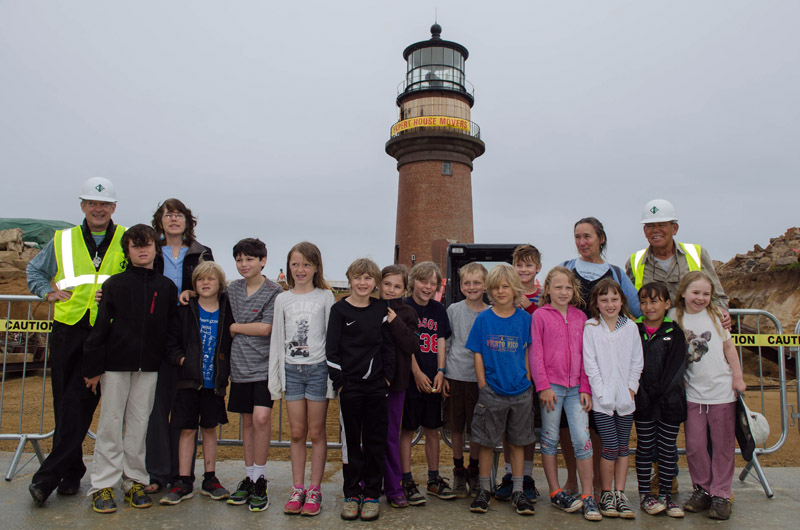
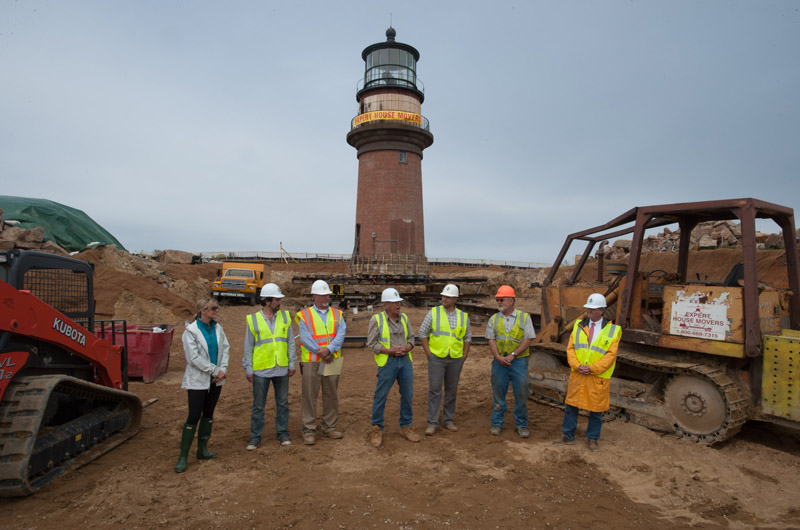
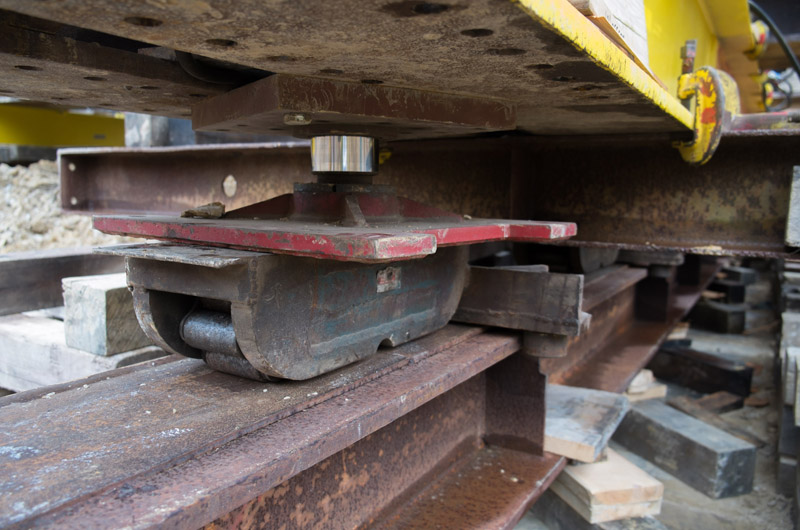
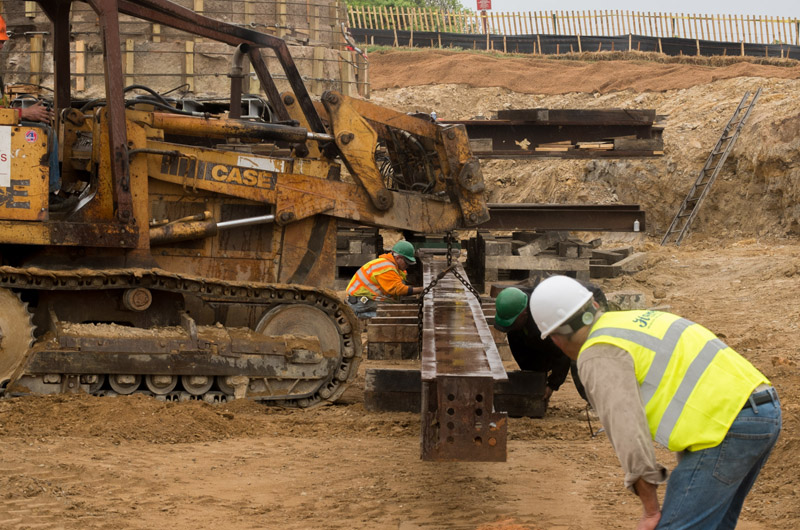

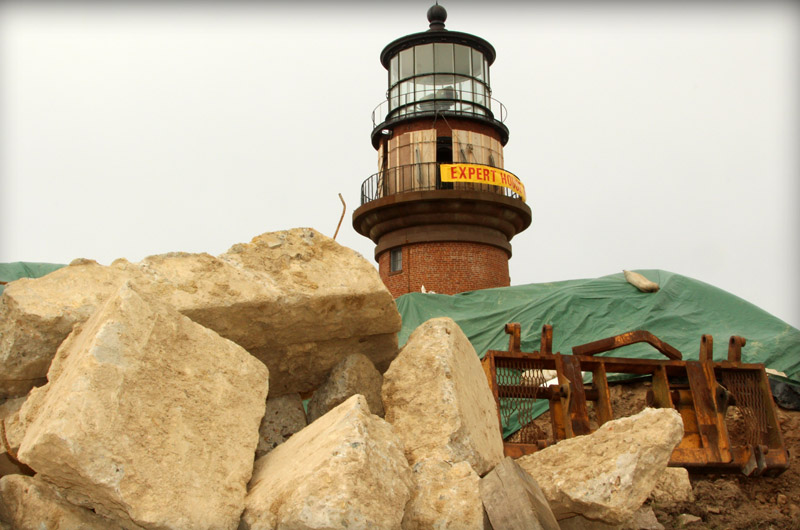





Comments (6)
Comments
Comment policy »